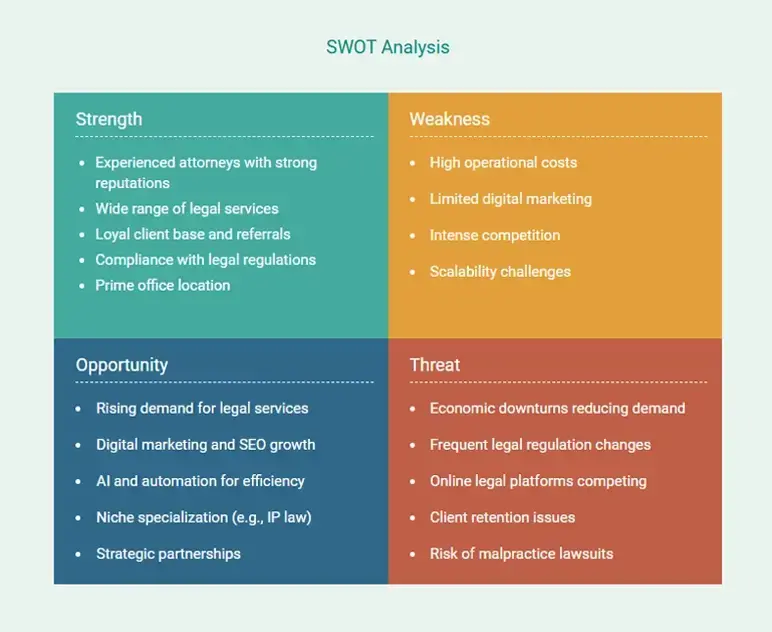Starting your own law firm is exciting—finally calling the shots, choosing your clients, and building something of your own.
But let’s be honest—figuring out the business side can feel like a whole new legal case you never studied for. That’s exactly what Clayeo Arnold, now the founder and CEO at “Arnold Law Firm”, went through when he started his firm.
I had a sit down with Clayeo to hear how he navigated the challenges, stayed on top of the business side, and built a firm he’s proud of.
His experience shaped this law firm business plan guide—so you can start strong without second-guessing every step.
Let’s get into it.
Why need a business plan for a law firm?
A business plan isn’t just a document—it’s what keeps your firm on track and sets you up for success. Here’s why you need one to practice law at a new law firm:

- Gives you a clear path: Instead of figuring things out as you go, you’ll know exactly what your goals are, what services you offer, and who your clients are.
- Keeps your finances in check: Helps you set fair rates, track expenses, and make sure your firm is actually making money.
- Makes getting clients easier: You’ll have a solid plan for bringing in new clients and keeping them long-term.
- Prepares you for surprises: Slow months? Unexpected costs? A business plan helps you stay ahead instead of scrambling.
- Helps you get funding: If you ever need a loan or investor, a plan shows them you’re serious and know what you’re doing.
A business plan makes running your firm easier, smarter, and way less stressful.
How to create a solid law firm business plan?
Here’s a simple guide to help you write a comprehensive business plan:
1. Executive summary
The executive summary is the first section of your business plan, giving a snapshot of your firm and what makes it stand out.
This section sums up your entire plan and is key to grabbing the attention of potential investors, partners, or lenders. That’s why it needs to be clear, concise, and compelling.
Here’s what to include:
- Your law firm’s mission and business model
- Market opportunity in the legal industry
- Your unique selling proposition (briefly)
- Target market, clients, and practice areas
- Your competitive edge and unique approach
- Marketing strategies to attract and retain clients
- Financial outlook and growth potential
Think of your executive summary as your elevator pitch—it should quickly explain what your law firm is about and why it will succeed.
"Writing my executive summary seemed easy at first—it’s just a summary, right? But it ended up being one of the hardest parts. The real challenge was figuring out what made my firm stand out in a crowded legal field.
I realized it wasn’t just about the legal services I offer—it was about my approach, the trust I build with clients, and the way I simplify complex legal matters. That became the foundation of my plan." —Clayeo Arnold
2. Company overview
Every law firm has a story—here’s where you tell yours (firm description). Start with the basics: your firm’s name, location, legal niche, and legal structure (sole proprietorship, LLC, or partnership).
Then, dive into how it all began. What made you start your firm? Was it a passion for helping clients navigate the legal system? A gap in the industry you knew you could fill? Share the journey, the challenges you overcame, and any big wins along the way.
Next, talk about your mission statement—what drives your firm beyond just winning cases? Maybe it’s providing personalized legal support, making the law more accessible, or offering a modern, client-focused approach.
Finally, lay out your goals for the future. Are you aiming to expand your client base, add new services, or grow your team? This section should give a clear, down-to-earth picture of where your firm stands today and where you want to take it.
"It was tough to pinpoint what made Carter Legal Group truly stand out. I knew expert legal services were essential, but every firm offers that.
The breakthrough came when I realized clients weren’t just looking for legal representation—they wanted a trusted advisor who truly listens and fights for them.
That’s when I knew my focus wasn’t just on winning cases—it was about giving clients confidence, clarity, and a legal partner they could rely on."—Clayeo Arnold
3. Law firm services (and product if any)
Your new law firm’s business plan should clearly outline the legal services you offer. This helps potential clients, partners, and investors understand your firm's focus and expertise.
In the services section, list the key legal services your firm provides. These may include:
- Corporate law
- Family law
- Criminal defense
- Personal injury
- Estate planning
- Intellectual property
- Employment law
Clearly defining your law firm services ensures potential clients and partners know exactly how you can help.
4. Market research and analysis
Before launching your law firm, you need a solid understanding of the legal industry. This section proves you’ve done your research and understand the landscape.
When conducting market research and analysis, consider these key factors:
- Market size
- Growth potential
- Regulatory requirements
Additionally, stay updated on industry trends, such as the rise of virtual legal consultations, subscription-based legal services, and AI-powered legal research tools.
Clients are looking for efficient, cost-effective, and tech-savvy legal solutions—understanding these shifts can give your firm a competitive edge.
"When I started researching the legal industry for my business plan, most of the data felt too broad or outdated. I needed real insights, so I took a closer look—analyzing local law firms, reading client reviews, and speaking with people who had hired attorneys.
This hands-on research helped me see a gap in the market: clients weren’t just looking for legal representation—they wanted a firm that was more accessible, transparent, and client-focused. That’s where my firm could truly stand out."—Clayeo Arnold
5. Competitive analysis
For competitive analysis, you’ll analyze the other estheticians and businesses that offer the same services as you. It helps you know how your company stands out from them.
Know your competitors. Do they fall into the categories of local spas, skincare clinics, or single estheticians? Try to go through their services, pricing, and customer reviews to see where they do a good job and where they don’t.
Next, examine their strengths and weaknesses. For example, maybe they have great customer service but not much variety in products. Or they may have a great location but it is too pricey.
By knowing these, you can determine opportunities to give something better or different.
Consider how you can stand out. Do you have services no one else can offer, lower prices, or better customer service?
"When I looked into my competitors, I saw plenty of law firms offering similar legal services—but none with the same level of client-focused attention I wanted to provide.
I realized that prioritizing accessibility, transparency, and a more personal approach could make my firm stand out in a crowded market.
By studying what worked—and what didn’t—I found ways to carve out a niche and build a practice that truly put clients first."—Clayeo Arnold
6. SWOT analysis
A SWOT analysis helps you assess your law firm’s strengths, weaknesses, opportunities, and threats. Understanding these factors gives you a clear picture of where you stand and how to position your firm for success.
Here’s what is included:
Strengths (What sets your firm apart?)
- Specialized expertise in a particular area of law
- Strong client relationships and personalized service
- Competitive pricing or flexible payment options
- Reputation for winning cases or providing excellent legal advice
- Use of legal technology to streamline processes
Weaknesses (Challenges to improve on)
- Limited brand awareness as a new or small firm
- Higher operational costs compared to competitors
- Dependence on word-of-mouth rather than a structured marketing plan
- Limited staff or lack of certain legal specializations
Opportunities (Growth potential)
- Expanding into underserved legal markets
- Offering virtual legal services for greater accessibility
- Leveraging digital marketing to attract new clients
- Partnering with other businesses for referrals
Threats (External challenges to watch out for)
- Increasing competition from larger firms or legal tech platforms
- Changes in laws and regulations affecting your practice area
- Economic downturns reducing client demand for legal services
- Difficulty in attracting and retaining top legal talent

A SWOT analysis helps you play to your strengths, work on weaknesses, seize opportunities, and prepare for challenges—so your law firm can grow and thrive.
"When I stepped back and looked at my law firm’s strengths and weaknesses, I realized success wasn’t just about offering legal services—it was about knowing where I stood in the market.
Understanding what set me apart, where I could improve, and what opportunities were out there helped me build a firm that wasn’t just another practice, but one that truly met clients’ needs."—Clayeo Arnold
7. Marketing strategy
Your law firm marketing plan should focus on how you’ll attract and retain clients while growing your practice.
It’s not just about getting your name out there—it’s about building trust and credibility in a competitive industry.
Here are some effective marketing techniques to consider:
- Building a strong online presence
- SEO and content marketing
- Social media engagement
- Email newsletters
- Networking and referrals
- Speaking at events or hosting webinars
- Local advertising
A solid marketing strategy helps you bring in new clients, maintain relationships, and show potential investors or partners that your firm has long-term growth potential.
"Creating a marketing strategy for my law firm took time, but it was essential for standing out in a crowded industry.
Instead of just relying on referrals, I focused on building an online presence—sharing legal insights, answering common questions, and engaging with potential clients on social media.
Providing valuable content and networking with other professionals helped establish trust and attract new clients."—Clayeo Arnold
8. Operations plan
Your law firm’s operations plan lays out the daily processes needed to keep your practice running efficiently while delivering top-notch legal services.
Here are key points to consider:
- Client management: How will you handle client intake, consultations, and case management? Will you use a CRM or case management software?
- Office setup: Will your firm operate from a physical office, offer virtual consultations, or use a hybrid model?
- Staffing and roles: Will you be a solo practitioner, or will you hire paralegals, legal assistants, or administrative staff?
- Case tracking and document management: What software or system will you use to manage legal documents, deadlines, and filings?
- Billing and payments: Will you use hourly rates, flat fees, or contingency-based pricing? What software will handle invoicing and payments?
- Compliance and security: How will you store confidential client information securely and stay compliant with legal regulations?
- Client communication: Will you offer online scheduling, automated follow-ups, or client portals for better service?
Answering these questions ensures your law firm’s daily operations run smoothly, keeping clients satisfied and your practice growing.
"I quickly realized how important it was to have a solid system in place to keep my law firm running smoothly—from client consultations to case management.
I set up an organized workflow for scheduling, document management, and billing, which helped reduce stress and kept everything on track.
Running a law firm isn’t just about providing legal services—it’s about having the right processes in place to ensure efficiency and a seamless client experience."—Clayeo Arnold
9. Management team and organization
Your law firm’s management team plays a crucial role in running the practice efficiently and building client trust. Whether you're a solo attorney or have a growing team of lawyers, the management team section outlines who’s responsible for what and the projected size of your team.
Introduce yourself
Start with your background—your education, legal experience, and the skills that make you qualified to lead your firm. Highlight any past roles, key cases, or specializations that set you apart.
Team structure
List your team’s key roles and responsibilities:
- Managing partner/founder – Leads the firm, oversees strategy, and handles major cases
- Associate lawyers or attorneys – Manage client cases, court filings, and legal research
- Paralegals and legal assistants – Support attorneys with documentation, case prep, and filings
- Office manager – Handles scheduling, billing, and day-to-day operations
- Marketing & client relations – Manages branding, social media, and client communication
Organizational chart
Including an organizational chart makes it easy to see who reports to whom and how responsibilities are structured in your own firm.

For example:
If you have legal industry mentors, business consultants, or financial advisors, mention them in this section.
Their expertise adds credibility to your plan and reassures investors or partners that you have the right guidance to grow successfully.
"Building a strong management team for my law firm wasn’t just about hiring staff—it was about finding people who shared my commitment to client service and legal excellence.
Having experienced professionals handling casework, operations, and client relations allowed me to focus on growing the firm, knowing that day-to-day tasks were in capable hands."—Clayeo Arnold
10. Financial plan
Your law firm’s financial plan provides a clear roadmap of where your business is headed financially over the next 3-5 years.
It helps you stay on track, manage expenses, and prove your company’s profitability to potential investors or lenders.
This is also a good place to mention if your seeking funding or loans and how you plan to repay and utilize it.
Key Financial Statements to Include:
- Profit and loss statement
- Cash flow statement
- Balance sheet
- Break-even analysis
- Funding requirements
A well-structured financial plan reassures investors and lenders that your law firm is built for long-term profitability and sustainability.
"When I started my financial plan, I knew it was essential for my firm’s success, but breaking down costs, pricing, and revenue projections was more complicated than I expected.
Without past data to rely on, I researched other firms, legal industry trends, and market demand. I factored in service pricing, billable hours, and seasonal fluctuations to make realistic projections.
By mapping out multiple financial scenarios—best, worst, and most likely—I gained a clearer picture of my firm’s financial future and built a plan I could confidently follow."—Clayeo Arnold
Download our free law firm business plan template
Ready to create your business plan but need a little extra help? We’ve got you covered! Download our law firm business plan template PDF to get started.
This investor-friendly template has helped many attorneys build a solid foundation for their firms. With clear examples and expert tips, it makes writing your business plan easier and more effective than ever.
Final thoughts
Now that you’ve gone through this guide, crafting a business plan for your new firm should feel much more manageable.
If you need expert guidance, our business plan consultants are here to help. They’ll offer expert insights and assist you in refining your plan to match your firm’s specific goals and core values.
Don’t put it off—start building a strong, strategic business plan today!
Frequently Asked Questions
What should be covered in a successful law firm business plan?
Your business plan should include:
- Executive summary
- A high-level overview and legal structure of the business
- Customer and target market analysis
- Competitors analysis
- Marketing plan
- Management team
- Financial plan
- Operation plan
Can I use my law firm business plan to secure funding?
Yes, a well-structured plan increases your chances to achieve funding:
- Lenders and investors look for clear financial projections and growth plans
- A strong plan shows your firm's profitability and long-term sustainability
- Helps you secure business loans, private investments, or grants
How do I create accurate financial projections for my small law firm business plan?
Financial projections should be realistic and based on industry research:
- Estimate revenue based on billable hours, retainer fees, or flat-rate services
- Include startup costs, overhead expenses, and operational costs
- Consider best-case, worst-case, and realistic financial scenarios
What common mistakes to avoid in a business plan?
Avoiding common mistakes helps your business plan stand out:
- Skipping market research and failing to identify direct and indirect competitors
- Overestimating revenue and underestimating operating expenses
- Ignoring potential clients acquisition strategies and sustainable growth planning
How long does it take it write a business plan for a law firm?
The time it takes depends on how detailed your plan is:
- A simple business plan may take a few days to a couple of weeks
- A comprehensive plan with financial projections can take a month or more
- Investing time upfront ensures a well-structured, effective strategy

